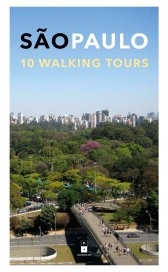This guide is for those who believe that the best way to get to know a city is by foot. It is geared toward those for whom walking through the streets, observing and experiencing little day-to-day things, and coming into contact with the incredible urban, social, and cultural diversity of a metropolis such as São Paulo as interesting as viewing its main attractions.
The guide offers ten different walking tours that provide a close-up view of the ins and outs of the city and its urban life, including historical and contemporary sites. It is an opinionated guide whose authors do not hesitate to suggest what they find most interesting. This will allow you to get a full urban experience as you get to know the wonderfull city of São Paulo.
All tours (except number 8, which takes you through Parque Ibirapuera) begin and end at Metro stations. São Paulo’s Metro system is a simple way to move through and situate oneself in the city. Furthermore, these subway lines pass through central places that facilitate access to the tours’ routes. In order to ride the Metro, you must buy tickets at the booths or machines at each station. Even better is to buy a “Bilhete Único” metro pass into wich you can load mony and not have to pay for each trip separately. Every walk is designed for daytime and, for many, we indicate the most interesting days and most convenient times.

Foto divulgação [São Paulo 10 Walking Tours]
The introduction to each walking tour summarizes its main points of interest and “style” so as to enable you to choose which paths to take. A map depicts each tour’s route and the Metro stations that mark its start and end points. The maps that begin each walk have the Portuguese name of each Metro line along its number and color. The black dots represent places with specific addresses while streets are marked with blue doors. The maps use the Portuguese names as you will see them on signs. Whitin the chapters, the Metro lines (with number and color) are in English and the place names and streets names are in both Portuguese and English.
The first five tours are practically contiguous—the areas covered are within no more than a 5-km radius, allowing you to mix and match them at will. All tours are designed to traverse mostly public spaces with a few exceptions being such as museums, bakeries, bars, and restaurants—but this is not a hotel, shopping, or gastronomic guide.

Ladeira Porto Geral
Foto divulgação [São Paulo 10 Walking Tours]
We do not underestimate the difficulty of moving through a city like São Paulo. Therefore, we selected routes in which a visitor can get lost (in the best sense of the word) and find his or her way back at any moment. A series of obstacles stand in the way of enjoying São Paulo’s attractions, such as the city’s sheer enormity, central regions that are poorly maintained and other phenomena common to all metropolises, like crowds, noise, and a healthy dose of chaos. Even so, this is a guide for people who love walking, observing, and admiring the local, mundane landscape. It will allow you to see those curious, unconventional things that only an outsider can detect while sipping a cup of coffee in a new place, trying a new food at a hole-in-the-wall restaurant, turning an obscure corner, or having a casual conversation.
Go on, discover São Paulo on foot, it’s worth it!

Municipal Market
Foto divulgação [São Paulo 10 Walking Tours]
note
This text is the Preface of the guide.
about the author
Roney Cytrynowicz studied economy and history in USP and acts as historian and editor of Narrativa 1. In 1994, he was in the finals of Premio Jabuti in the Short Stories category with his book: A vida secreta dos relógios e outras histórias (The secret life of the clocks and other stories, in free translation).



![Pages from the guide<br />Imagem divulgação [<i>São Paulo 10 Walking Tours</i>]](https://vitruvius.com.br/media/images/magazines/grid_9/7428d0e09a30_sp10_guia01.jpg)
![Pages from the guide<br />Imagem divulgação [<i>São Paulo 10 Walking Tours</i>]](https://vitruvius.com.br/media/images/magazines/grid_9/e5084adbaab7_sp10_guia02.jpg)
![Pages from the guide<br />Imagem divulgação [<i>São Paulo 10 Walking Tours</i>]](https://vitruvius.com.br/media/images/magazines/grid_9/912c109c2057_sp10_guia03.jpg)
![Pages from the guide<br />Imagem divulgação [<i>São Paulo 10 Walking Tours</i>]](https://vitruvius.com.br/media/images/magazines/grid_9/6a2f3113c3cf_sp10_guia04.jpg)
![Pages from the guide<br />Imagem divulgação [<i>São Paulo 10 Walking Tours</i>]](https://vitruvius.com.br/media/images/magazines/gallery_thumb/7428d0e09a30_sp10_guia01.jpg)
![Pages from the guide<br />Imagem divulgação [<i>São Paulo 10 Walking Tours</i>]](https://vitruvius.com.br/media/images/magazines/gallery_thumb/e5084adbaab7_sp10_guia02.jpg)
![Pages from the guide<br />Imagem divulgação [<i>São Paulo 10 Walking Tours</i>]](https://vitruvius.com.br/media/images/magazines/gallery_thumb/912c109c2057_sp10_guia03.jpg)
![Pages from the guide<br />Imagem divulgação [<i>São Paulo 10 Walking Tours</i>]](https://vitruvius.com.br/media/images/magazines/gallery_thumb/6a2f3113c3cf_sp10_guia04.jpg)

